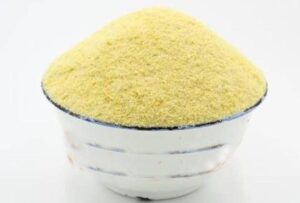This article is a special request I received from some readers. This is a difficult article since meal preparation has many ingredients. However, I tried every possible means to research this significant subject. I will focus on the scientific review of the four major ingredients used (Beans, Gari, fried Plantain, and Palm oil). The other ingredients are minor so I will not focus on them but they add up to the taste and holistic benefits.
Black-eyed peas – science
Weight loss
Two studies (Bloom et al.2006; Lomenick et al.2009 ) found that the protein in gob3 reduces levels of ghrelin, a hormone that’s responsible for stimulating feelings of hunger.
On the other hand, as a soluble fibre, Lattimer and Haub’s (2010) study found that this fibre is a type of fibre that forms a gel-like consistency and goes into your digestive tract slowly to make you full. This account for why most people like eating gob3 to keep them for the day. Eating beans, therefore, helps to manage your weight.
For instance, one large study in 1,475 people by Papanikolaou and Fulgoni(2008) found that people who ate beans frequently had a 23 percent lower risk of increased belly fat and a 22 percent lower risk of obesity, compared with non-consumers.
Another study’s (Kim et al.2016) review of 21 studies found that consuming black-eyed peas, in your diet (gob3) could be an effective weight loss strategy and may help reduce body fat percentage.
Digestive health
Yang et al.(2012) demonstrates that when we eat more gob3, the soluble fibre can help promote regularity and increase stool frequency in those with constipation.
Anderson et al.(2009) also found that the fibre in gob3 may avert digestive disorders, such as acid reflux, haemorrhoids, and stomach ulcers. Another good news is that one study by Carlson et al.(2019) found that the soluble fibre found in black-eyed peas and other plants can also act as a prebiotic, which helps the growth of the beneficial bacteria in our gut to help foster a healthy microbiome.
Heart health
Eating gob3 also reduces your risk of heart diseases. Bazzano et al. (2009) review of 10 studies found that frequent eating of legumes was linked to lower levels of total and LDL (bad) cholesterol, which could add to heart disease.
Alizadeh et al. (2014) study on 42 women found that when we eat a low-calorie diet enriched with 1 cup of legumes per day for 6 weeks drastically decreased waist circumference and triglyceride and blood pressure levels, juxtaposed with a control group. Three studies (Esmaillzadeh and Azadbakht, 2012; Hosseinpour-Niazi et al. 2015; Golia et al. 2014) found that frequent consumption of legumes is linked to lower markers of inflammation, and therefore reduces your risk of heart disease.
Gari, science
Cassava gari is a resistant starch. Magallanes-Cruz et al.(2017) explained that resistant starch is starched that the small intestine does not digest. Nugent, (2005) explained that resistant starch work in a similar manner to dietary fibre. They pass from the small intestines into the colon where they begin to ferment and finally promote gut health by feeding the beneficial gut bacteria as they ferment(Maier et al.2017).
Palm oil
Palm oil – scientific benefits
Support brain health, heart health
Palm oil is loaded with tocotrienols, a form of vitamin E which contains antioxidants that may support brain health. In the human study Gopalan et al. (2014) conducted for 2-years involving 121 people with brain lesions, the group who took palm oil-derived tocotrienols twice a day remained stable, but for those who received a placebo, their lesions grow.
Though some study results have been mixed, this oil largely appears to have beneficial effects on heart disease risk factors, including lowering LDL (bad) cholesterol and increasing HDL (good) cholesterol (Fattore et al.2011; Ismail et al.2018; Lucci et al.2016; Voon et al. 2015)
In the case of Fattore et al. (2011), the study involved a large analysis of 51 studies and found that total and LDL (bad) cholesterol levels were lower in people who consumed palm oil-rich diets than those who consumed diets high in trans fats or myristic and lauric acids.
In a previous clinical trial, Zhang et al. (1997) also examined the effects of palm oil, soybean oil, peanut oil, and lard on cholesterol levels. The authors found that palm oil caused a 13.1 percent decrease in bad LDL cholesterol and a 6.7 percent drop in triglyceride levels in those with normal cholesterol. Apart from palm oil lowering your cholesterol levels, it also slows the progression of heart diseases.
Enhanced vitamin A
One old study by McLaren (1999) and a recent review study by Tan et al. (2021) found that red palm oil enhances vitamin A status in people who are deficient or at risk of deficiency because it’s rich in carotenoids that the body can convert into vitamin A.
Another small study in 16 participants by Sommerburg et al. (2015) found that people with cystic fibrosis, a condition that makes it difficult to absorb fat-soluble vitamins, experienced an increase in vitamin A blood levels after taking two to three tablespoons of red palm oil daily for 8 weeks.
A previous clinical trial by Radhika et al. (2013) also found that Palm oil is mostly used as a supplement to help improve vitamin A status in those who are at risk for deficiency. This study emanated from the National Institute of Nutrition, Indian Council of Medical Research in India, for example, showed that treating pregnant women with red palm oil increased vitamin A levels for both women and their babies. Another meta-analysis of nine high-quality studies by Dong et al. (2017) found red palm oil supplementation to increase vitamin A levels in both children and adults.
Fried plantain
Mixed study on glycemic index in plantain
Ogbuji et al.(2013) found that the average glycemic index for ripe plantain is 54.6 and 45.3 for unripe plantain. They also noted that the glycemic index values for fried, boiled and roasted ripe plantain are 56,54 and 55 respectively.
one study by Kouamé et al.(2017) in Côte d’Ivoire found plantain chips to have a GI of 45, which is within the low range(refer to my previous article on GI). The study did not support consuming ‘banane braisée’ (Charcoal-roasted light green stage plantain) which has a GI of 89 and uses the roasting method. The other cooking method for plantain such as chips used deep frying with major ingredients being salt, and refined palm oil.
A previous study by Ayodele and Godwin(2010) in Nigeria found no difference between boiled plantain (Bp), fried plantain (Fp), roasted plantain (Rp), boiled and pounded plantain (BPp), and plantain flour. The study found that roasted plantain gave the lowest glycemic index and the value was significantly lower than the other test foods.
Plantain – Science
Loaded with potassium, magnesium
Plantain contains 913 milligrams of potassium in one cup of cooked, mashed plantains. This is about 27 percent of the recommended daily amount of potassium, this gives plantains an advantage over cassava and makes it one of the most potassium-rich foods on the earth.
He and MacGregor (2008) study found that potassium contents also affect skeletal and smooth muscle contraction. Paunier’s (1992) study found that magnesium directly affects calcium absorption, which can avert or reverse osteoporosis.
Warning
Messina, V (2014) found that black-eyed peas are likely to cause stomach pain, gas, and bloating in some people due to their content of raffinose, a type of fibre that can aid digestive matters. However, this could be addressed by soaking and cooking dried beans to enable easier digestion. Alternatively, one can use tablets and pills to deal with the gas.
On the other hand, Masum et al. (2011) found that black-eyed peas also contain antinutrients, such as phytic acid, which bind to minerals like iron, zinc, magnesium, and calcium and prevent their absorption in the body. This, Gupta et al.(2015) found, can however be averted by soaking and cooking black-eyed peas before eating to drastically reduce their phytic acid content and help boost nutrient absorption.
Take home
So in conclusion black-eyed peas in gob3 may help increase weight loss, improve digestive health, and support better heart health. Also, the study on fried plantain is mixed on diabetics’ health. So I advise diabetics to eat gob3 moderately.
So this is what you get from eating gob3. I hope my review helps you. Always do remember that the starch content in cassava products is resistant starch and they are beneficial to our health, especially gut health.
>>>The writer is a Professor of Naturopathic Healthcare, President, Nyarkotey College of Holistic Medicine & Technology (NUCHMT)/African Naturopathic Foundation. E-mail: [email protected].













